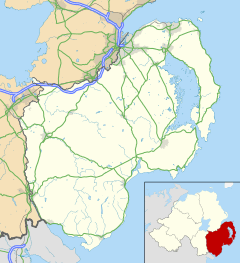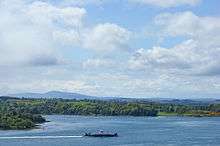Portaferry
| Portaferry | |
| Irish: Port an Pheire | |
| Portaferry from the pier towards the north |
|
 |
|
| Population | 2,514 (2011 Census) |
|---|---|
| Irish grid reference | J594509 |
| District | Ards and North Down |
| County | County Down |
| Country | Northern Ireland |
| Sovereign state | United Kingdom |
| Post town | NEWTOWNARDS |
| Postcode district | BT22 |
| Dialling code | 028 |
| Police | Northern Ireland |
| Fire | Northern Ireland |
| Ambulance | Northern Ireland |
| EU Parliament | Northern Ireland |
|
|
Coordinates: 54°22′51″N 5°32′55″W / 54.3809°N 5.5486°W

Portaferry (from Irish Port a' Pheire, meaning "landing place of the ferry") is a small town in County Down, Northern Ireland, at the southern end of the Ards Peninsula, near the Narrows at the entrance to Strangford Lough. It has an aquarium and is well known for the annual Galway Hookers Regatta. It hosts its own small Marina, the Portaferry Marina. A passenger/car ferry service operates daily at 15-minute intervals (8am to 11pm) between the villages of Portaferry and Strangford, less than a mile apart, conveying about 500,000 passengers per annum. It had a population of 2,514 people in the 2011 Census.[1]
Commercial fishing for clams and king prawns and the farming of oysters and mussels takes place within the confines of Strangford Lough. This is supplemented by the presence in Portaferry of the Marine Laboratory of the Queen's University of Belfast.[2] There are fine Georgian buildings in the town square, including a Market House, now used as a community centre.
Portaferry Lifeboat is an essential lifeline for local fishermen and yachtsmen. In 1987 a lifeboat house was built aided by money raised through the Belfast Newsletter's Lord Louis Mountbatten Appeal Fund. In 1994 a new Atlantic 75 inshore lifeboat, also named 'Blue Peter V', replaced the Atlantic 21. (The Atlantic 75 is the fastest seagoing lifeboat in the RNLI's fleet and is capable of speeds up to 34 Knots.)[3][4]
History
In the 17th century Ulster ports began to rise in prominence. In 1625 William Pitt was appointed as Customer of the ports of Newcastle, Dundrum, Killough, Portaferry, Donaghadee, Bangor and Holywood.[5]
Demography
2011 Census
In the 2011 Census Portaferry had a population of 2,514 people (978 households).[1]
2001 Census
Portaferry is classified as an intermediate settlement by the NI Statistics and Research Agency (NISRA) (i.e. with population between 2,250 and 4,500 people). On Census day (29 April 2001) there were 2,467 people living in Portaferry. Of these:
- 25.1% were aged under 16 years and 18.2% were aged 60 and over
- 50.4% of the population were male and 49.6% were female
- 89.1% were from a Catholic background and 9.7% were from a Protestant background
- 4.6% of people aged 16–74 were unemployed.
For more details see: NI Neighbourhood Information Service
Places of interest

- Portaferry is the home of the Northern Ireland Aquarium – Exploris.[6] It was opened by Ards Borough Council in 1987 and extended and re-opened by Prince Charles in 1994 as Exploris. It is Northern Ireland's premier marine life centre and aquarium, featuring walk-through tanks which house examples of Strangford Lough's marine inhabitants.
- Roads Service (Department for Regional Development) operates a car ferry service across Strangford Lough between the villages of Strangford and Portaferry. To travel the distance between Strangford and Portaferry by road is approximately 75 kilometres and takes about an hour and a half by car. By contrast, the ferry route is approximately 0.6 nautical miles (1.1 km) with a typical crossing time of about 8 minutes.[7]
- Portaferry Castle is a small 16th-century tower house built by William Le Savage.[8] It is a square building with a small projecting turret at the south corner. It is three storeys high plus attic. There is no vault. Most of the eastern corner is ruinous.
People
- Bishop Robert Echlin, Bishop of Down and Connor (1612–1635) is buried in the ancient ruins of Templecraney, Portaferry off Church St.
- Portaferry's famous sons include two brothers, the tenor Peter Tomelty and the actor and playwright Joseph Tomelty, born in Portaferry in 1911.[9] Priest, philosopher and poet Father Vincent McNabb was also born in Portaferry.
- Actor Oliver Reed visited Portaferry regularly up until his death, usually arriving by boat from his holiday home in Cork and staying several days at a time.
- Actor Errol Flynn was an occasional visitor to the town at one time. His Father Theodore Thomson Flynn was a Professor at Queen's University Belfast, and who for many years rented a holiday house on the shores of Strangford Lough, at Kilclief.
- Portaferry was the location for a new BBC comedy/drama series The Invisibles, which was broadcast in 6-hour-long episodes starting 1 May 2008. It starred Anthony Head better known as the Prime Minister in Little Britain and Rupert Giles, Librarian and Watcher in Buffy the Vampire Slayer. The series also starred Jenny Agutter star of The Railway Children and An American Werewolf in London. The series was filmed in Portaferry, but local shops and hotels were disguised to appear as locations in Devon, England.
- Portaferry was also a location for the BBC drama series Small Island. This time, the town doubled for a Yorkshire town during World War II. The Square was used extensively with the old Stewart & James' shop disguised as a cinema and the Market House as a Tearoom in a crucial scene. It starred Benedict Cumberbatch (Sherlock) as Bernard, Naomie Harris (Pirates of the Caribbean: At World's End) as Hortense, Ruth Wilson (Luther) as Queenie and David Oyelowo (Blood and Oil) as Gilbert.
- Football legend and Manchester United star George Best lived briefly in the neighbouring village of Portavogie and visited Portaferry regularly during this time.
- Jazz and Blues star Van Morrison has stayed locally and once took his friend Bob Dylan on a tour of the area.
Environment

The Portaferry area is popular with local and foreign tourists for its beauty, history, wildlife and other visitor attractions. Other pursuits enjoyed in the area are angling, wildfowling and birdwatching. Strangford Lough is the largest sea inlet in the British Isles.
It is Northern Ireland's first Marine Nature Reserve and is renowned as an Area of Outstanding Natural Beauty and Special Scientific Interest, with six National Nature Reserves within its reaches. Over 2000 species of marine animals have been found in the Lough and internationally important flocks of wildfowl and wading birds converge there in winter. The Lough is also the most important site in Ireland for breeding common seals.
Sport
GAA sports, particularly Hurling are popular in the area and Portaferry GAC were Ulster Club Hurling Champions in 2014. There are two other GAA clubs nearby, Ballygalget and Ballycran, and there is intense rivalry between the three.
Diving is an increasingly popular pastime, and approximately 70 Sub-aqua clubs currently use the area throughout the year. Portaferry Rovers F.C. are a local Football team who complete in division 1C of the Northern Amateur Football League
Industry
Portaferry industrial activities include agriculture, fishing, tourism. 'Suki Tea' announced as of 2014 that experimental tea growing will commence in the area, utilizing the relatively warm and dry climate, with frost protection from Strangford lough. 'Exploris' aquarium may cease trading as of 2014 due to lack of funding, with local people striving to maintain it. Portaferry's access to Strangford Narrows is being used for testing a scale model of Evopod, a Tidal Stream Turbine; for electricity generation.[10] In 2008 a twin rotor 1.2MW SeaGen was installed; it generates 10MWh of energy. Tidal energy, unlike wind or wave, is a renewable energy resource which can be predicted.[www.marineturbines.com]
Gallery
- Portaferry from the pier towards the south
- The Portaferry ferry returning from Strangford.
- Portaferry Marina.
- Portaferry Castle.
- Portaferry from the pier towards the north
 Portaferry From Castleward.
Portaferry From Castleward.
See also
- List of towns and villages in Northern Ireland
- List of RNLI stations
- Market Houses in Northern Ireland
References
- 1 2 "Portaferry". Census 2011 Results. NI Statistics and Research Agency. Retrieved 22 April 2015.
- ↑ Marine Laboratory
- ↑ Portaferry Lifeboat
- ↑ Culture Northern Ireland – Portaferry Lifeboat Station
- ↑ O'Sullivan, Aidan & Breen, Colin (2007). Maritime Ireland. An Archaeology of Coastal Communities. Stroud: Tempus. p. 211. ISBN 978-0-7524-2509-2.
- ↑ Exploris
- ↑ "About the Ferry". Northern Ireland Roads Department. Retrieved 13 September 2009.
- ↑ Portaferry Castle
- ↑ Culture Northern ireland – Joseph Tomelty
- ↑ First Testing of Evopod at Strangford Narrows
| Wikimedia Commons has media related to Portaferry. |
External links
- Exploris
- Portaferry Gala Week
- Culture Northern Ireland
- Portaferry Sailing Club
- Naomh Padraig Port an Pheire, Down Senior Hurling Champions 2006
- Portaferry RNLI Lifeboat Station
- Ardbrae Country House
